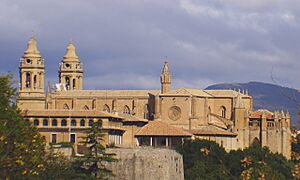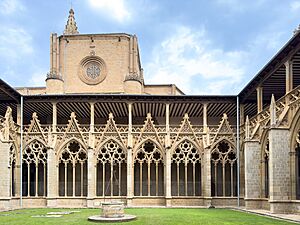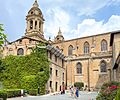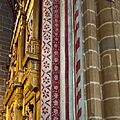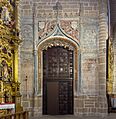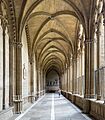Pamplona Cathedral facts for kids
Quick facts for kids Cathedral of Saint Mary of the AssumptionCatedral de Santa María de la Asunción |
|
|---|---|
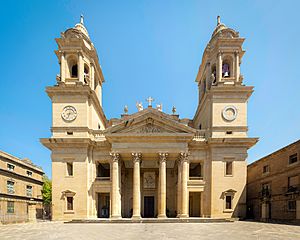
Pamplona Cathedral
|
|
| Religion | |
| Affiliation | Roman Catholic Church |
| District | Archdiocese of Pamplona y Tudela |
| Rite | Roman |
| Ecclesiastical or organizational status | Cathedral |
| Location | |
| Location | Pamplona, Spain |
| Architecture | |
| Architectural type | Church |
| Architectural style | Neoclassical, Gothic, Romanesque, Baroque, Renaissance |
The Pamplona Cathedral, also known as the Cathedral of Saint Mary of the Assumption, is a famous Catholic church in Pamplona, Spain. The church you see today was built in the 15th century in the Gothic style. It replaced an even older church from the Romanesque period. Digging deep, archaeologists have even found signs of two churches that existed before that!
The front of the cathedral, called the facade, was designed in 1783 by Ventura Rodríguez. It has a Neoclassical look. The cathedral also has a beautiful Gothic cloister from the 13th and 14th centuries. A cloister is an open space, usually with covered walkways, often found in monasteries or cathedrals. This cloister leads to two other Gothic rooms: the Barbazan chapel and the refectory.
In the past, the kings of Navarre were crowned here. Some of them were also buried within the cathedral. The Navarrese Cortes, which was like their parliament, used to meet here in earlier times.
Since it was first built, the church has been dedicated to Santa María de la Asunción (Saint Mary of the Assumption). Her special day is celebrated on August 15th. Sometimes, people call it Santa María la Real. This name became popular after a special event in 1946. However, historians say its original name was simply Santa María de Pamplona.
Contents
Exploring the Church
The spot where the cathedral stands is the oldest part of the ancient Roman city of Pompaelo. In 1994, archaeologists found streets and buildings from the 1st century BC here. The very first cathedral on this site was destroyed in 924 during an invasion by Abd-al-Rahman III.
Later, during the rule of King Sancho III (1004–1035), the church was rebuilt. That church was then taken down between 1083 and 1097. A new Romanesque cathedral was built from 1100 to 1127. Sadly, this one collapsed in 1391, with only its front remaining.
The building of the current Gothic church began in 1394 and finished in 1501. It has a cruciform shape, like a cross, with a main central area called a nave and four smaller aisles. All these areas have beautiful arched ceilings called rib vaults, some of which are painted. The design of this church was greatly influenced by French Gothic styles.
Inside, you can see amazing sculptures. One important piece is the tomb of Charles III of Navarre and Eleanor of Castile. This tomb was made by Jehan Lome de Tournai in 1419. There is also a special statue called Royal Saint Mary. It is a Romanesque wooden sculpture covered in silver.
The choir, where singers sit, has beautiful Renaissance choir stalls from 1541. It is separated from the main nave by a Gothic iron screen from 1517. There used to be a large Renaissance altarpiece from 1598 in the front part of the church, but it is now in the church of Saint Michael in Pamplona. In the side chapels, you can find two Gothic altarpieces (around 1500 and 1507). There is also one Italian Renaissance altarpiece from the 16th century, and five Baroque altarpieces from the 17th century.
The Cloister: A Peaceful Place
Perhaps the most amazing part of the cathedral is its cloister, built in the 13th century. Like the church itself, its style follows French Gothic architecture. The sculptures here are very detailed and beautiful.
The door leading from the church to the cloister shows a scene of the Virgin Mary falling asleep, called the Dormition of the Virgin. In the middle of the doorway stands a 15th-century sculpture of the Virgin Mary.
The Barbazan chapel is named after Bishop Arnaldo de Barbazán of Pamplona, who is buried there. It has a Gothic ceiling with eight ribs. Another special door, called the 'Precious Door', leads to the old canons' dormitory. This door tells a complete story of the Virgin Mary's life through its sculptures.
Many important people are buried here. These include Bishop Miguel Sánchez de Asiáin (14th century), the Viceroy of Navarre Count of Gages (18th century), and the famous guerrilla fighter Francisco Espoz y Mina (19th century). There is also a washing area, closed off by an iron gate. People say the iron for this gate came from the battle of Navas de Tolosa. Another decorated Gothic door leads to the old kitchen and the refectory, which was a dining hall.
Diocesan Museum: Treasures of Art
The old rooms where the canons (church officials) used to live now house the Diocesan Museum. The main room is a large refectory from the 14th century, with a ribbed ceiling. The kitchen next to it has a unique pyramid-shaped stone chimney.
This museum displays many religious art pieces. These come from the cathedral itself and from other churches in Navarre, many of which are no longer used. You can see sculptures from the Romanesque, Gothic, Renaissance, and Baroque periods. There are also Gothic and Baroque paintings, and beautiful gold and silver items made between the 13th and 18th centuries.
Some of the most impressive silver pieces include a Gothic Holy Sepulcher reliquary (a container for holy relics) made in Paris in the 13th century. There is also a 14th-century Lignum Crucis reliquary, which holds a piece of the True Cross. Another highlight is a stunning Renaissance processional monstrance from the 16th century, used to display the consecrated host during religious ceremonies.
Images for kids
See also
 In Spanish: Catedral de Pamplona (España) para niños
In Spanish: Catedral de Pamplona (España) para niños


